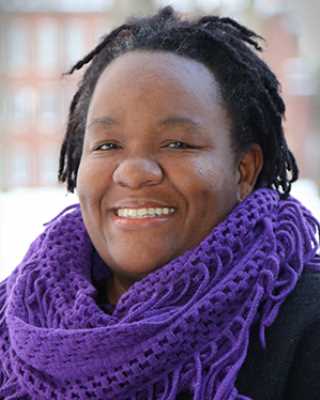When Dr. LaKendra Hardware resigned from her position at Goshen College, she launched an immediate and different conversation on campus: Who would take over the work she was doing?
Widely known as Dr. LaKendra, she was one of 17% of total full-time administrators and staff of color representing GC’s predominantly white campus. The college is now tasked with filling Hardware’s post.Hardware arrived at GC as a campus pastor in 2018. She soon transitioned to director of diversity, equity and inclusion (DEI). She held many leadership positions during her tenure, including advising the Black Student Union (BSU) and serving on the Bias Matters Response Team.
Gilberto Perez Jr., the vice president of student life, spent four years working in an adjacent office to Hardware in Wyse Hall. In his own words, he had numerous chances to “see her shine.”
”She was very interested in racial equity and continues to be,” he said. “She really wanted to do more of that.”
Her contributions will now be seen on a larger stage. Hardware began work in July as an equity transformation specialist at Courageous Conversations, a national association devoted to forging racial equity and providing training, coaching and consulting to organizations.
Hardware could not immediately be reached for comment.
Perez explained that Courageous Conversations is deeply engaged in racial justice, so although he is sad about Goshen’s loss, he is happy for Hardware, knowing that “she’s going to thrive even more than she did here.”
In the meantime, GC is responding to Hardware’s departure by initiating faculty searches to determine who will fill her positions.
Perez noted that he is working to ensure that Hardware’s roles are covered.
She co-chaired the committee of DEI at the institutional level, a position that Perez said he would now assume.
As for GC’s Black Faculty Fellowship, a group that Hardware led for conversation and mutual support, it is expected that a new leader will be appointed later this semester.
“The other area Dr. LaKendra was working on was intercultural student support,” Perez said. “I’m happy to say that we’re 99% complete on all those advisers.”
Apart from the institutional response, there is also the personal vacuum left by Hardware’s departure, especially on the part of students of color.
Nakiyah Kilpatrick, American Sign Language (ASL) interpreting major and the BSU president, expressed concerns regarding her adviser’s departure.
Without Hardware on campus, Kilpatrick worries that current and future students will not feel the support she felt because of the lack of faculty of color at GC.
“It’s a great loss because Dr. LaKendra was more than just staff; she was family,” Kilpatrick said. “I was struggling with Black representation in the world of interpreting. She was able to help me process my emotions and heal from experiences that traumatized me.”
Last year, a panel titled “Through Our Eyes” took place at GC. Kilpatrick brought the idea to fruition to raise awareness that people of color face obstacles in the interpreting field.
“She helped me channel all [my] energy into a workshop that was not only therapeutic to me but educational to others,” Kilpatrick said. “She was my mirror; she showed me that I am a strong Black woman and a great leader.”
According to Justin Heinzekeher, the director of institutional research, 38% of students, undergraduate and graduate, are BIPOC (Black, Indigenous, Person of Color).
But the percentage of college employees of color falls sharply. For full-time teaching faculty, it’s 5%. For full-time administrators and staff, it’s 17%.
Perez also spoke about the importance of diversifying the staff: “Growing up, I saw a lot of my teachers as people who looked like me. It was a motivator—if we have more staff and faculty of color, I think we can have a more thriving college.”
In the college’s strategic plan, one of the objectives is to engage DEI for all employees. For the 2022-23 academic year, the strategic plan lists a goal to hire 10-20% BIPOC.
Ann Vendrely, vice president of academic affairs and academic dean, noted that this goal is for BIPOC new hires in “all employee categories” and that “we anticipate having a number for faculty searches.”
“One of the things important to Goshen College is that we want to attract a diverse student body,” said Marlene Penner, the human resources director. “In order to do that, it would be great if there were faculty and staff that were diverse also.”
Penner explained that the college attempts to hire more people of color through job listings, utilizing websites like Diversity in Higher Education that BIPOCs are more likely to visit.
GC also engages DEI for employees through implicit bias training and requires every department to develop evaluation tools that encompass those standards.
Penner noted the college is not where it needs to be, but “it’s definitely a priority that we want to have happen.”
To build an even more inclusive campus, Kilpatrick hopes that GC continues to check any biases, which includes avoiding stereotypes or microaggressions and supporting and listening to intercultural students.
Penner said, “I want to make sure that we don’t lose that vision of the hiring process—If we try one thing and it doesn’t work, let’s try something different.”
Perez also voiced his future hopes for GC: “I would hope that we as an institution continue to see the other person as someone that we can be in a relationship with–and that we see ourselves as a place for students who want to come and be a part of a community that’s focused on strong core values.”
“I think about Dr. LaKendra; she loved to play with words,” Perez continued. “And one of the words she created was, #DoBetterGC.”



